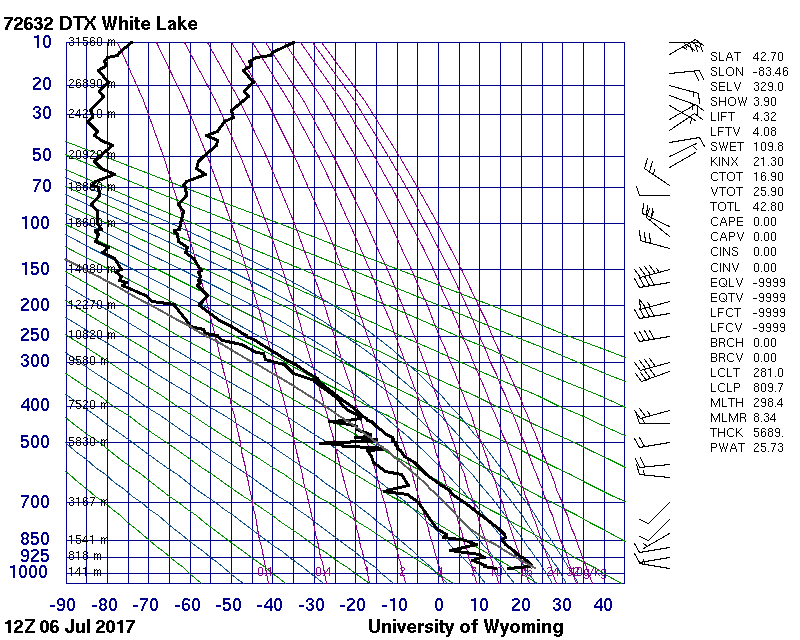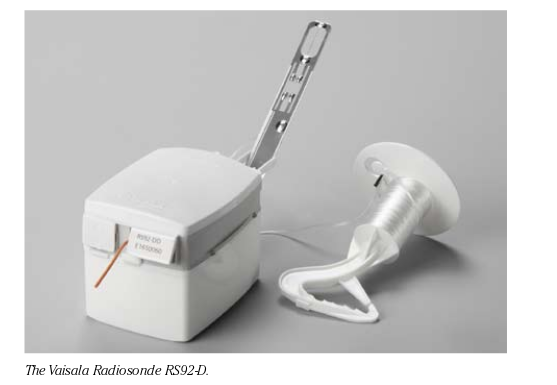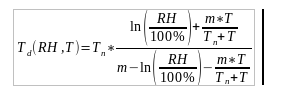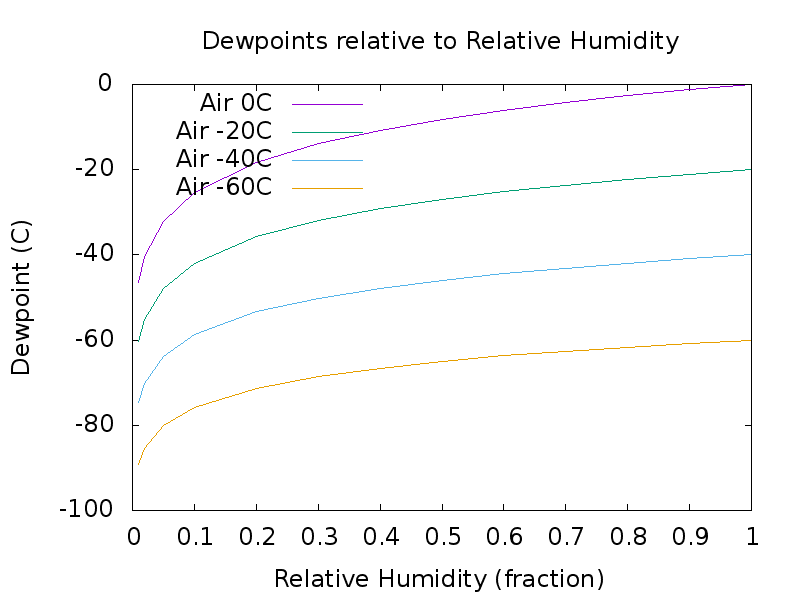Abstract
This is a survey of humidity measurement methods and some of the solid state devices available to perform humidity measurements. I am looking for methods suitable for making stratospheric balloon sounding dew point measurements. I intend to try this using an SHT-31A breakout board from ClosedCube. This sensor should be able to see the drop of humidity in the tropopause, but may not read stratospheric humidity.
Introduction
I am interested in making and understanding stratospheric humidity measurement using a high altitude balloon. Two pieces of of information are available from tropospheric measurements: cloud and potential cloud levels; and water content n the atmosphere, i.e. the amount of moisture potentially available for precipitation. The Stratosphere presents an extreme environment with very low temperatures and low humidity, as shown in a typical weather balloon sounding.

In the balloon sounding shown above, the temperatures above 150 mbar are -55C to -65C, while the dew points are -75C to -85C
First I’d like to find out what methods are available to measure humidity, and how the weather service makes measurements.
Methods
First a warning. I am not a meteorologist, so any speculation here may not be worth the paper its printed on. What? you say this is not printed on paper? Well! Print it out! Anyway, I will try to label my speculations appropriately. You may think of them as mental notes to myself.
Humidity measurement methods may report relative humidity or absolute humidity. Relative humidity is the fraction of moisture that the air can hold at a particular temperature. Because warm air can hold more moisture, the relative humidity will drop at higher temperatures for a given amount of evaporated water in the air. It is reported as a percentage of the moisture possible. If the relative humidity is at or above 100% water will condense to water droplets as fog or clouds or rain.
Absolute humidity is a measure of the water vapor in the air. It may be reported as grams/m3 but is usually reported as a dew point, that is the temperature at which water will begin to condense. Summer time, tropical humidities may have dew points in the 70s Fahrenheit to 80s F. As a glasses wearer, I know that it is very humid if when I emerge from an air conditioned building to warm/hot air outside and my glasses fog over. Likewise in the winter, when coming inside from the cold outdoors into a warm, more humid building, my glasses may fog over. These are both examples where the glasses temperature is below the dew point. In balloon soundings, when the dew point reaches the ambient temperature, clouds may form. I suspect that the dew point can be used to guess at overnight low temperatures under reasonably clear skies. As the air temperature tries to go below the dew point, water or ice condensation releases heat, which in turn warms the air. The temperature may not be able to fall further until the water content of the air is reduced.
Hygrometers use a water sensitive material that changes length or force to measure relative humidity. Often this moves a dial mechanism to indicate the relative humidity.
Speculation alert! I do not understand why the relative humidity methods are sensitive to the fraction of possible water in the air instead of the total moisture available. Perhaps they indicate an equilibrium between water condensing and water evaporating? end speculation.
A psychrometer compares a ‘dry’ temperature reading with the temperature of water evaporating from a wick (wet bulb). Speculation alert! I would like to think the wick is at the dew point, but it may only be fractionally near the dewpoint. end speculation. Tables are consulted to determine the relative humidity at the dry bulb temperature. The method runs into trouble at freezing temperatures.
A chilled mirror Dewpoint measurement is an absolute humidity measurement. However instead of reporting the measurement as a density, grams of H20/ m^3, it is measured and reported as a temperature. The temperature of a mirror is controlled at or around the temperature where water condenses on it. That temperature, where condensation begins to occur, is the dew point. The condensation can be observed as degradation of reflected light from the mirror.

Weather service balloon sounding uses a solid state devices. From the Vaisalia RS-92 data sheet, it uses two thin film capacitor type sensors. This appears to be a proprietary system, since I’ve had difficulty trying to find out more about it.
Solid state devices seem to report a relative humidity. An example is the Honeywell HIH-4030, which is available as a breakout board from Sparkfun. These are often sensors whose capacitance varies with humidity. The dielectric constant varies with moisture. See the Vaisalia white paper below. Speculation Alert! I would think this gives a device sensitive to absolute humidity instead of relative humidity. Apparently I’m wrong. end speculation. But circuitry is included to convert that capacitance to a voltage. However, Sparkfun says the HIH-4030 uses a conductive polymer, so this may indeed be a resistive device. These devices may become less accurate a very low < 20%, or very high humidity >80%. Speculation Alert! I think these may reflect non-linear behavior of the devices and the could be compensated for with more intensive calibration. See Figure 3 of the HIH-4030 data sheet. end speculation. Also these devices have a temperature dependence so there may be additional corrections for temperature. See Figure 4 of the HIH-4030 data sheet. On page 2 of the data sheet, the temperature dependence/compensation of the HIH-4030 is given as True RH = (Sensor RH)/(1.0546 – 0.00216T), T in ºC . Often a temperature sensor is included in the humidity sensor package.
Information about some other sensors
Sensiron SHT71
Information contained in data sheet can be interesting, though it varies both by manufacturer, and by sensor. The Sensiron SHT7x data sheet is one that is especially useful. This is a capacitive sensor that includes both a humidity and temperature sensor. It is a digital sensor, using the I2C protocol. The signal processing includes calibration coefficients to improve the accuracy of the output. However these are often low-order (1st or 2nd) corrections, and especially since a temperature sensor is included, also include temperature compensation.
Using the 2nd order formula in section 4.1 of the data sheet can improve the accuracy of the humidity output.
RH(%) = c1 + c2*SORH + c3*SORH2
where SORH are the 8-bit (0-256) or 12-bit (0-4098) humidity read out values. Table 6 gives the coefficients for 8 and 12 bit readouts. For the 8 bit readouts c1=-2,0468, c2=0.5872, c3= -4.0845E-4. Note that 0%RH is a reading (about 4) and the 100%RH is significantly less than full scale.
Section 4.3 gives linear processing of the temperature readout of the form T=d1 + d2*SOT. Table 8 gives the coefficients, Note here that d1 is power supply voltage dependent, and gives the low limit of the temperature reading, about -40C.
An additional temperature compensation can be applied to the humidity readings using section 4.2.
RHtrue (%) = (TC – 25) * (t1 + t2*SORH) +RH(%)
with coefficients from table 7. For 8 bit readings, t1=0.01, and t2=0.00128.
Section 4.4 is the jackpot. It shows a calculation of the Dew Point from the relative humidity. This is an approximation, but is relatively simple and should be good enough for my purposes, and should work for any humidity sensor.

Above freezing (0C) Tn = 243.12C, m=17.62, and below freezing Tn=272.62C, m=22.46. Note that at RH of zero, this cannot be evaluated.
See the Sensiron Application note: Introduction to Humidity.
While an interesting sensor for stratospheric measurements, it has a 3% uncertainty in the humidity reading, and a hard limit on the lower temperature reading of -40C
Dew Point Calculations
Below are some plots of from the dew point formula above.

Results from the expression above can be compared to values from the NWS relative humidity calculator. The calculated values usually agree within a few %RH. There are other online dewpoint calculators where the agreement is not as good. However if I agree with the NWS, I think I’m implementing the formula correctly. This graph convinces me that I will not be able to measure stratospheric dewpoints of -80C to -85C reliably. With the device at -40C even 2 %RH gives a dewpoint of -70C. Measurements below this will be unreliable. Speculation Alert! This does have me wondering what the limits of the NWS sensors are. Are the -80C to -85C dew points real or an artifact of the measuring sensor? End speculation.
Results from the expression above can be compared to values from the NWS relative humidity calculator. The calculated values usually agree within a few %RH. There are other online dewpoint calculators where the agreement is not as good. However if I agree with the NWS, I believe I’m doing something right. This graph convinces me that I will not be able to measure stratospheric dewpoints of -80C to -85C reliably. With the device at -40C even 2 %RH gives a dewpoint of -70C. Measurements below this will be unreliable. Speculation Alert! This does have me wondering what the limits of the NWS sensors are. Are the -80C to -85C dew points real or an artifact of the measuring sensor? End speculation.
Sense Hat HTS221
The Sense Hat for the Raspberry Pi uses an HTS221 Humidity/Temperature sensor. This also is a capacitive relative humidity sensor. It is a digital sensor with a 16 bit ADC with I2C or SPI digital communications. It has a 3.5% accuracy for 20%-80% RH, and 5% accuracy outside that range. It appears to use 2-point calibration, ie a linear fit. I am a little confused about the interpolation processing, It could probably be cleared up by looking a Raspberry Pi Sense Hat code. Speculation alert! Section 8 of the data sheet give some example data for T0=10C and T1=20C, with approximate values of 300 and 500 respectively. This gives slope of 20/C, and a lowest bound reading of zero corresponds to -5C. Its clear I am missing something. It may be that the Temperatures in registers 32 and 33. need to be read directly, as well as the values in registers 3C-3F from Table 19. The sample data in section 8 may not be representative of the real data. End speculation. The HTS has poor accuracy for my stratopheric purposes, and may have a low temperature bound that is too high.
SHT-31A

The SHT-31A, available as a breakout board from ClosedCube, is an analog device. Since it uses Sensirion’s CMOSens® sensor chip, I assume it is a capacitive sensor like the SHT-71. It uses an internal calibration/temperature compensation table to display a corrected relative humidity. While its lower limit in tolerance, is -40C, it may have a hard low temperature limit of -45C but it may instead give readings down to -67C (of unknown accuracy) from the data sheet, section 4, equation 2. A balloon flight may tell which is the case. It is also possible that the device may “freeze” up and not work at extremely cold stratospheric temperatures. At very low temperatures it should be compared to another source. I plan to supplement this device with an RTD temperature sensor during balloon missions. This device claims a 2% accuracy instead of the 3% accuracy of the above devices. It also appears to maintain that accuracy across the whole 0-100 %RH range, not losing accuracy at the low and high ends of the range, My intention is to, as a first effort, compare results to to nearby NWS balloon soundings to see in the device works reasonably well. Speculation alert! It might be possible to check or improve the RH calibration by measuring RH as the device is warmed or cooled in a known dew point environment. End speculation. As noted above, the reliability of dew point measurements below -70C is probably suspect. But this device should be able to see the drop in dew point in the tropopause boundary layer.
Conclusion
The primary purpose of this post was to organize my own thoughts about how to do a balloon borne humidity measurement. I hope that others find it useful to. My understanding is that NWS uses a capacative solid state device for its twice daily balloon soundings, though optical dewpoint devices are available, mostly for ground measurements, but possibly for balloon sounding. I plan to use the SHT-31A for my flights, due to its affordability ($13 +shipping), reasonable accuracy, and its potential for out of range measurements.
References and Humidity links:
in no particular order…
Vaisala: Methods of accurately Measuring Capacitive RH Sensors (pdf)
http://scienceline.ucsb.edu/getkey.php?key=480 Horse hair humidity sensor
Click to access jresv93n4p551_A1b.pdf
http://archives.sensorsmag.com/articles/0997/humidity/ accuracy
http://archives.sensorsmag.com/articles/0799/49/index.htm Chilled mirror method
https://www.tindie.com/products/closedcube/sht31-a-analog-humidity-and-temperature-sensor/ a SHT-31A analog breakout board
A Beginner’s Guide to Humidity Measurement,
https://www.sparkfun.com/datasheets/Sensors/Weather/SEN-09569-HIH-4030-datasheet.pdf Data Sheet for HIH-4030
https://www.sensirion.com/fileadmin/user_upload/customers/sensirion/Dokumente/2_Humidity_Sensors/Sensirion_Humidity_Sensors_SHT3x_Datasheet_analog.pdf Data Sheet for SHT-31A
https://www.sensirion.com/fileadmin/user_upload/customers/sensirion/Dokumente/2_Humidity_Sensors/Sensirion_Humidity_Sensors_SHT7x_Datasheet_V5.pdf Data Sheet for SHT-71
https://www.sensirion.com/fileadmin/user_upload/customers/sensirion/Dokumente/2_Humidity_Sensors/Sensirion_Humidity_Sensors_Introduction_to_Relative_Humidity_V2.pdf Sensiron Application Note: Introduction to humidity
http://www.st.com/content/ccc/resource/technical/document/datasheet/4d/9a/9c/ad/25/07/42/34/DM00116291.pdf/files/DM00116291.pdf/jcr:content/translations/en.DM00116291.pdf HTS221 Humidity/Temperature sensor used on the Sense Hat
http://www.wpc.ncep.noaa.gov/html/dewrh.shtml NWS relatuve humidity calculator from Temperature and dew point.
http://www.vaisala.com/Vaisala%20Documents/Brochures%20and%20Datasheets/RS92-D-Datasheet-B210763EN-B-LoRes.pdf Vaisalia RS-92 data sheet.
©2017, David B. Snyder

